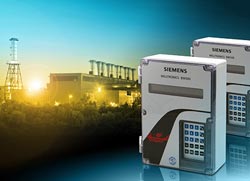Accurate belt scale integrators for increased efficiency in simple and complex applications

The Milltronics BW500 and BW500/L belt scale integrators of the Siemens Industry Automation division provide unequaled accuracy based on the patented electronic load cell-balancing feature, providing improved efficiency in simple and complex applications.
The new version, developed specifically for simple applications with belt scales, has two relays. It calculates rate, totalized weight, belt loading and belt speed. The relays are programmable SPST form A contacts rated 5A at 250 V AC non-inductive, reversible. An automatic calibration function saves time during operation. Both versions store parameter data in a non-volatile Flash memory; measurement and control data is always available, even if the unit loses power. The standard Milltronics BW500 comes with five relays, offers additional PID control and batching in its functionalities and is specially designed for complex applications.
First launched in 1999, Milltronics BW500 is widely used in the food, cement, aggregate and mining industries. Operating with any belt scale or weighfeeder with up to six strain gauge load cells or LVDT (linear variable differential transformer), the BW500 processes belt load and speed signals for accurate flow rate and totalized weight of bulk solids. The new BW500/L can be used with one or two-load cell belt scale systems. Both versions can be connected to industrial networks via Profibus DP, Allen Bradley RIO and DeviceNet. They are also compatible with Sitrans RD500 remote data manager.
Both versions’ patented electronic load cell-balancing feature make them a world leader in system accuracy. Used with the MMI belt scale, Milltronics BW500 is ideal for fast-moving belts, short idler spacing, and light or uneven belt loading. Combined with Milltronics MSI and MMI belt scales and a speed sensor, Milltronics BW500 has various approvals for custody transfer and legal for trade applications, including OIML (International Organization of Legal Metrology), MID (Measuring Instruments Directive), NTEP (National Type Evaluation Program), and Electronic Indicator/Totalizer approval from Measurement Canada.
The Siemens Industry Sector (Erlangen, Germany) is the worldwide leading supplier of production, transportation, lighting and building technologies. With integrated automation technologies as well as comprehensive industry-specific solutions, Siemens increases the productivity, flexibility and efficiency of its customers in the fields of industry and infrastructure. The Sector includes six divisions: Building Technologies, Drive Technologies, Industry Automation, Industry Solutions, Mobility and Osram. By September 30, Siemens Industry had some 204,000 employees worldwide and turnover in fiscal year 2010 of €34.9 billion. http://www.siemens.com/industry
The Siemens Industry Automation Division (Nuremberg, Germany) is the worldwide leading supplier of automation technology, industrial switchgear and industry software. The offer ranges from standard products for the manufacturing and process industry up to industry specific solutions with the automation of complete automobile productions and chemical plants. As leading software supplier Industry Automation optimizes the whole value chain of producing companies – from product design and development through production and sales up to service. By September 30, Siemens Industry Automation had some 33.000 employees worldwide and a turnover in fiscal year 2010 of €6.2 billion. http://www.siemens.com/industryautomation
Reference Number: IIA2011012608e
Media Contact
More Information:
http://www.siemens.com/weighingAll latest news from the category: Machine Engineering
Machine engineering is one of Germany’s key industries. The importance of this segment has led to the creation of new university degree programs in fields such as production and logistics, process engineering, vehicle/automotive engineering, production engineering and aerospace engineering among others.
innovations-report offers informative reports and articles covering technologies such as automation, motion, power train, energy, conveyor, plastics, lightweight construction, logistics/warehousing, measurement systems, machine tools and control engineering.
Newest articles

A universal framework for spatial biology
SpatialData is a freely accessible tool to unify and integrate data from different omics technologies accounting for spatial information, which can provide holistic insights into health and disease. Biological processes…

How complex biological processes arise
A $20 million grant from the U.S. National Science Foundation (NSF) will support the establishment and operation of the National Synthesis Center for Emergence in the Molecular and Cellular Sciences (NCEMS) at…

Airborne single-photon lidar system achieves high-resolution 3D imaging
Compact, low-power system opens doors for photon-efficient drone and satellite-based environmental monitoring and mapping. Researchers have developed a compact and lightweight single-photon airborne lidar system that can acquire high-resolution 3D…





















